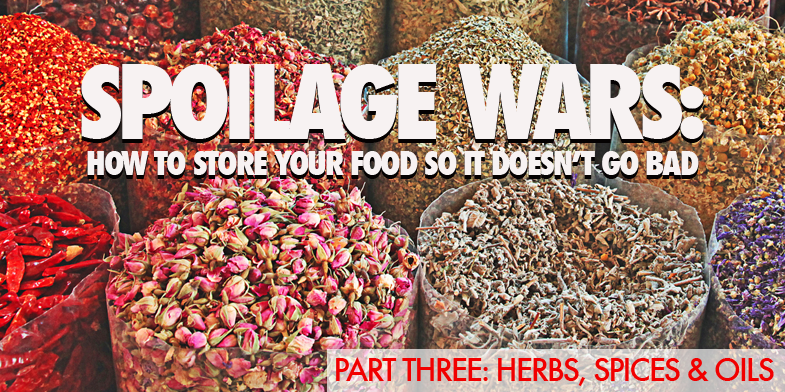
Keep Your Herbs Moist, Your Spices Away From The Stove, And Other Food Storage Tips Image courtesy of Allan
You may not use things like cumin, honey, or sage in every meal, but these are the kinds of ingredients that many home cooks keep on hand so they can use them whenever they’re called for. But how do you keep that paprika from turning into colorful sawdust? And what’s the best way to store that fresh parsley so it won’t be dried up and useless a few days after you buy it?
In previous installments of Spoilage Wars, we gave you storage advice for sensitive supermarket purchases like dairy, eggs, and bread; followed by a look at the best ways to keep fresh fruits and vegetables… well, fresh.
Today, we once again turn to Julia Collin Davison — executive food editor for the book division of America’s Test Kitchen and on-screen test cook for America’s Test Kitchen and Cook’s Country from America’s Test Kitchen — to get some advice on those ingredients that are essential to good cooking, but often go neglected.
FRESH HERBS:
Where to store them: In the refrigerator, preferably with some moisture.
Keep ’em moist: You can keep fresh herbs in the fridge for up to a couple of weeks if treated right, says Davison. Snip off the ends of your fresh herbs stand them in a small glass with a little bit of water in the bottom. Right next to the milk carton will do just fine. Another option is to wrap them in damp paper towels and put the whole bundle in a plastic bag in the fridge.
SPICES:
Where to store them: At room temperature, but not near the oven, stove or other heat source.
Crazy from the heat: Sure, that really nice over-the-stove spice rack looks great and it’s really convenient when whipping up a goulash on a Tuesday night, but Davison says heat is the enemy of spices.
“It’s just a place that will ruin them,” Davison says, noting that a stale, tasteless spice won’t do you much good. Unless you’re trying to make stale and tasteless the next big thing in cuisine.
“The key is when you open the jar and you put your nose close the opening, and you can’t smell it? Those things are dead,” says Davison, “There’s no point putting it in your cooking.”
DELICATE OILS (LIKE TRUFFLE OIL OR WALNUT):
Where to store them: Refrigerator
Anywhere in particular? In the door works; it’s got that rack and everything.
“Refrigeration preserves their more delicate flavors,” explains Davison about these products, while confirming that more robust oils like olive, corn, canola, and peanut are fine in the pantry.
HONEY:
Where to store it: In the pantry, room temperature. Honey is one of the most shelf-stable food items you can buy. Some people get a little freaked out when their honey crystalizes, but that doesn’t mean the stuff has gone bad.
Davison says there is no sure-fire way to prevent honey from crystalizing, but give the container a bath in warm water to get it liquid again. Don’t make the same mistake as my colleague Chris Morran, who has to heat up a large stock pot with hot water to warm up the mammoth jug o’ honey he bought at a store whose name rhymes with Costco.
CONDIMENTS:
While we’d love to tell you there are hard and fast rules about where to store all your various condiments, Davison says there are just too many variations and too many different ingredients that could decide whether something should go in the fridge or in the pantry. That’s why many commercially available condiments have storage instructions on the label. Davison says you can’t really screw up by following whatever the label says.
That’s it for now on Spoilage Wars. If you have a food storage question you’d like us to investigate, shoot us an e-mail with “SPOILAGE WARS” in the subject line at tips@consumerist.com and maybe it will be answered in a future post.
Want more consumer news? Visit our parent organization, Consumer Reports, for the latest on scams, recalls, and other consumer issues.

